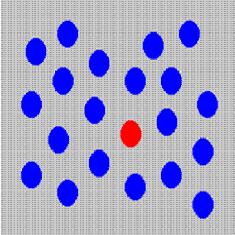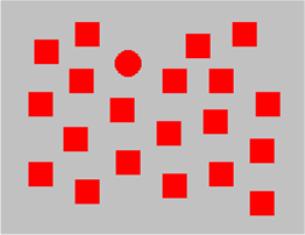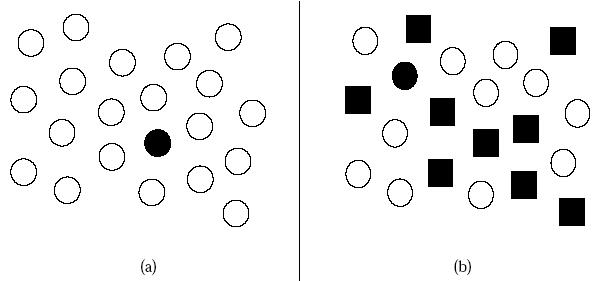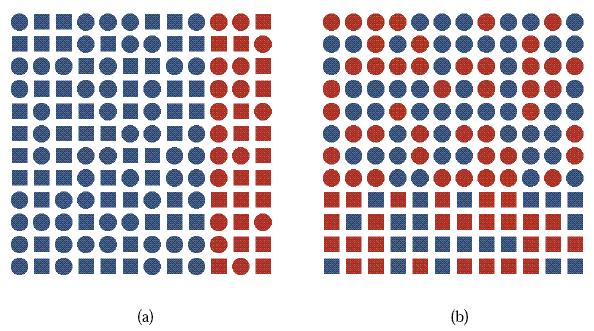Teaching:TUW - UE InfoVis WS 2005/06 - Gruppe G3 - Aufgabe 1 - Preattentive Processing: Difference between revisions
No edit summary |
No edit summary |
||
| (18 intermediate revisions by 3 users not shown) | |||
| Line 1: | Line 1: | ||
= Preattentive Processing = | = Preattentive Processing = | ||
{{Quotation| | {{Quotation|Visualization is so effective and useful because it utilizes one of the channels to our brain that have the highest bandwidths: our eyes. But even this channel can be used more or less efficiently. One special property of our visual system is preattentive processing. |[Ware, 2000; Treisman, 1985]}} | ||
<br>Healey, et al. [Healey et al., 1996] mentions in their paper that only a limited set of visual properties exists. Tasks, which can be accomplished within 200 milliseconds, are considered preattentively because eye movements need this time to initiate. Everything which can be perceived in this short time includes only absconding information. Attention can not be prefocused on a particular position if elements are set random. | |||
== Preattentive Features == | |||
A list of two-dimensional features that “pop out” during visual search, and a list of authors who describe preattentive tasks performed using the given feature, are listed in the table of the Figure 1. | |||
The various properties and the tasks for which the features are used is described in detail in the literature. [Healey et al., 1996] | |||
[[Image:Features.jpg|thumb|none|400px|Figure 1: two-dimensional features <br> [Healey et al., 1996]]] | |||
[[Image:Preattantive_1.jpg]] | {| align="right" | ||
| [[Image:Preattantive_1.jpg|thumb|none|200px|Figure 2: preattentively Red object detection. <br> [Chipman, 1996]]] | |||
| [[Image:Preattantive_2.jpg|thumb|none|250px|Figure 3: preattentively circle detection. <br>[Chipman, 1996]]] | |||
|} | |||
== Examples == | |||
=== Examples of one target detection tasks === | |||
[[ | (a) In Figure 2, the preattentively detection of the Red Object is showed. [Chipman, 1996] It displays that one visual variable is very easy to find it. <br> | ||
(b) In Figure 3, the preattentively detection of the Circle is showed.[Chipman, 1996] It is more difficult but still preantentiv. | |||
Figure 5: | {| align="right" | ||
| [[Image:Preattentive_4.JPG|thumb|none|350px|Figure 4: Target can be detected preattentively. <br> [Healey et al., 1996]]] | |||
| [[Image:Preattentive_3.JPG|thumb|none|350px|Figure 5: Target cannot be detected preattentively. <br> [Healey et al., 1996]]] | |||
|} | |||
<br><br><br><br><br><br><br><br><br> | |||
=== Examples of two target detection tasks === | |||
(a) In Figure 4a and 5a, the target can be detected preattentively because it possess the feature “filled”; <br> | |||
(b) In Figure 4b and 5b, the target cannot be detected preattentively because it has no visual feature that is unique from its distractors. [Healey et al., 1996] | |||
<br><br><br> | |||
== Conclusion == | |||
Any visual processing of that item prior to the act of selection can be called “preattentive” [Wolfe, Treisma, 2003], and preattentive processing can help to rapidly draw the focus of attention to a target with a unique visual feature (i.e., little or no searching is required in the preattentive case). [Healey, 2005] | |||
== Ressources == | |||
*[Healey et al., 1996] Healey, C. G., Booth, K. S., and Enns, J. T.. High-Speed Visual Estimation Using Preattentive Processing. ''ACM Transactions on Human Computer Interaction'' 3(2), pages 107-135, Created at: 1996. http://www.csc.ncsu.edu/faculty/healey/download/tochi.96.pdf . | *[Healey et al., 1996] Healey, C. G., Booth, K. S., and Enns, J. T.. High-Speed Visual Estimation Using Preattentive Processing. ''ACM Transactions on Human Computer Interaction'' 3(2), pages 107-135, Created at: 1996. http://www.csc.ncsu.edu/faculty/healey/download/tochi.96.pdf . | ||
Latest revision as of 21:21, 26 November 2009
Preattentive Processing[edit]
Healey, et al. [Healey et al., 1996] mentions in their paper that only a limited set of visual properties exists. Tasks, which can be accomplished within 200 milliseconds, are considered preattentively because eye movements need this time to initiate. Everything which can be perceived in this short time includes only absconding information. Attention can not be prefocused on a particular position if elements are set random.
Preattentive Features[edit]
A list of two-dimensional features that “pop out” during visual search, and a list of authors who describe preattentive tasks performed using the given feature, are listed in the table of the Figure 1. The various properties and the tasks for which the features are used is described in detail in the literature. [Healey et al., 1996]

[Healey et al., 1996]
 [Chipman, 1996] |
 [Chipman, 1996] |
Examples[edit]
Examples of one target detection tasks[edit]
(a) In Figure 2, the preattentively detection of the Red Object is showed. [Chipman, 1996] It displays that one visual variable is very easy to find it.
(b) In Figure 3, the preattentively detection of the Circle is showed.[Chipman, 1996] It is more difficult but still preantentiv.
 [Healey et al., 1996] |
 [Healey et al., 1996] |
Examples of two target detection tasks[edit]
(a) In Figure 4a and 5a, the target can be detected preattentively because it possess the feature “filled”;
(b) In Figure 4b and 5b, the target cannot be detected preattentively because it has no visual feature that is unique from its distractors. [Healey et al., 1996]
Conclusion[edit]
Any visual processing of that item prior to the act of selection can be called “preattentive” [Wolfe, Treisma, 2003], and preattentive processing can help to rapidly draw the focus of attention to a target with a unique visual feature (i.e., little or no searching is required in the preattentive case). [Healey, 2005]
Ressources[edit]
- [Healey et al., 1996] Healey, C. G., Booth, K. S., and Enns, J. T.. High-Speed Visual Estimation Using Preattentive Processing. ACM Transactions on Human Computer Interaction 3(2), pages 107-135, Created at: 1996. http://www.csc.ncsu.edu/faculty/healey/download/tochi.96.pdf .
- [Wolfe, Treisma, 2003] Jeremy M Wolfe, Anne Treisma. What shall we do with the preattentive processing stage: Use it or lose it?, Todd S Horowitz poster presented at the Third Annual Meeting of the Vision Sciences Society. Sarasota. Created at: May, 2003. http://search.bwh.harvard.edu/links/talks/VSS03-JMW.pdf .
- [Healey, 2005] Christopher G. Healey. Perception in Visualization. Department of Computer Science, North Carolina State University. Created at: May, 2005. http://www.csc.ncsu.edu/faculty/healey/PP/index.html#Tri_Cog_Psych:80 .
- [Chipman, 1996] Gene Chipman. Review of High Speed Visual Estimation Using Preattantive Processing (Healy, Booth and Enns). Created at: 1996, Accessed at: November 05, 2009. http://www.cs.umd.edu/class/spring2002/cmsc838f/preattentive.ppt#267 .
- [Treisman, 1985] A. Treisman. Preattentive processing in vision. Computer Vision, Graphics, and Image Processing, 31:156–177, 1985.
- [Ware, 2000] C. Ware. Information Visualization: Perception for Design. Morgan Kaufmann Publishers, 2000.